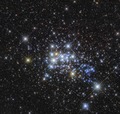Fil:Westerlund 1 - HST - Potw1710a.tif

Storleken för denna JPG-förhandsvisning av denna TIF-fil: 630 × 600 pixlar. Andra upplösningar: 252 × 240 pixlar | 504 × 480 pixlar | 806 × 768 pixlar | 1 075 × 1 024 pixlar | 2 151 × 2 048 pixlar | 2 748 × 2 617 pixlar.
Originalfil (2 748 × 2 617 pixlar, filstorlek: 11,07 Mbyte, MIME-typ: image/tiff)
Filhistorik
Klicka på ett datum/klockslag för att se filen som den såg ut då.
| Datum/Tid | Miniatyrbild | Dimensioner | Användare | Kommentar | |
|---|---|---|---|---|---|
| nuvarande | 6 mars 2017 kl. 08.09 |  | 2 748 × 2 617 (11,07 Mbyte) | Fabian RRRR | {{Information |Description=Home to a hypergiant Home to a hypergiant Light travels through space at just under 300 000 kilometres per second! This staggering speed is used to calculate astronomical distances; although often misinterpreted as a unit of... |
Filanvändning
Följande sida använder den här filen:
Global filanvändning
Följande andra wikier använder denna fil:
- Användande på de.wikipedia.org

